9、读写锁
ReentrantReadWriteLock
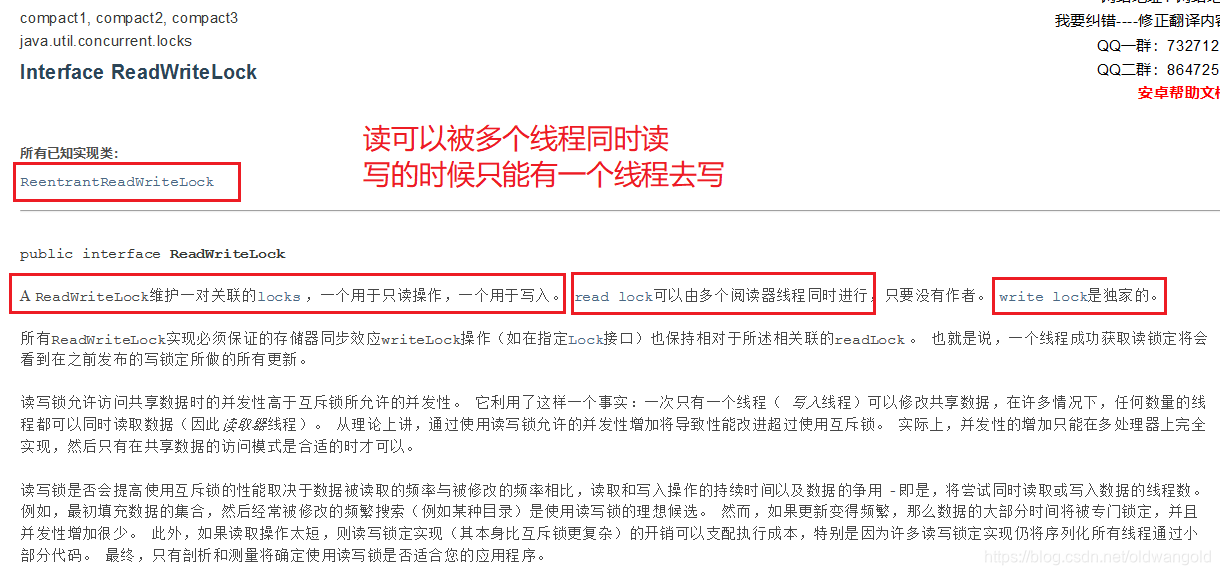
package com.won.rw;
import java.util.HashMap;
import java.util.Map;
import java.util.concurrent.locks.ReadWriteLock;
import java.util.concurrent.locks.ReentrantReadWriteLock;
/**
* 独占锁(写锁) 一次只能被一个线程占有
* 共享锁(读锁) 多个线程可以同时占有
* ReadWriteLock
* 读-读 可以共存
* 读-写 不能共存
* 写-写 不能共存
*/
public class ReadWriteLockDemo { // 线程操作资源类
public static void main(String[] args) {
//MyCache myCache = new MyCache();
MyCacheLock myCache = new MyCacheLock();
// 写入
for (int i = 1; i <= 5; i++) {
final int temp = i;
new Thread(()->{
myCache.put(temp+"",temp+"");
},String.valueOf(i)).start();
}
// 读取
for (int i = 1; i <= 5; i++) {
final int temp = i;
new Thread(()->{
myCache.get(temp+"");
},String.valueOf(i)).start();
}
}
}
// 加锁的
class MyCacheLock {
private volatile Map<String, Object> map = new HashMap<>();
// 读写锁:更加细粒度的控制
private ReadWriteLock readWriteLock = new ReentrantReadWriteLock();
// 存,写入的时候,只希望同时只有一个线程写
public void put(String key, Object value) {
readWriteLock.writeLock().lock();
try {
System.out.println(Thread.currentThread().getName() + "写入" + key);
map.put(key, value);
System.out.println(Thread.currentThread().getName() + "写入ok");
} catch (Exception e) {
e.printStackTrace();
} finally {
readWriteLock.writeLock().unlock();
}
}
// 取,读,所有人都可以读
public void get(String key) {
readWriteLock.readLock().lock();
try {
System.out.println(Thread.currentThread().getName() + "读取" + key);
Object o = map.get(key);
System.out.println(Thread.currentThread().getName() + "读取ok");
} catch (Exception e) {
e.printStackTrace();
} finally {
readWriteLock.readLock().unlock();
}
}
/**
* 3写入3
* 3写入ok
* 2写入2
* 2写入ok
* 1写入1
* 1写入ok
* 4写入4
* 4写入ok
* 5写入5
* 5写入ok
* 2读取2
* 2读取ok
* 1读取1
* 1读取ok
* 3读取3
* 3读取ok
* 4读取4
* 4读取ok
* 5读取5
* 5读取ok
*/
}
/**
* 自定义缓存
*/
class MyCache {
private volatile Map<String, Object> map = new HashMap<>();
// 存,写
public void put(String key, Object value) {
System.out.println(Thread.currentThread().getName() + "写入" + key);
map.put(key, value);
System.out.println(Thread.currentThread().getName() + "写入ok");
}
// 取,读
public void get(String key) {
System.out.println(Thread.currentThread().getName() + "读取" + key);
Object o = map.get(key);
System.out.println(Thread.currentThread().getName() + "读取ok");
}
/**
* 1写入1
* 4写入4
* 4写入ok
* 3写入3
* 3写入ok
* 2写入2
* 2写入ok
* 1写入ok
* 5写入5
* 5写入ok
* 1读取1
* 2读取2
* 2读取ok
* 1读取ok
* 3读取3
* 3读取ok
* 5读取5
* 5读取ok
* 4读取4
* 4读取ok
*/
}
10、阻塞队列
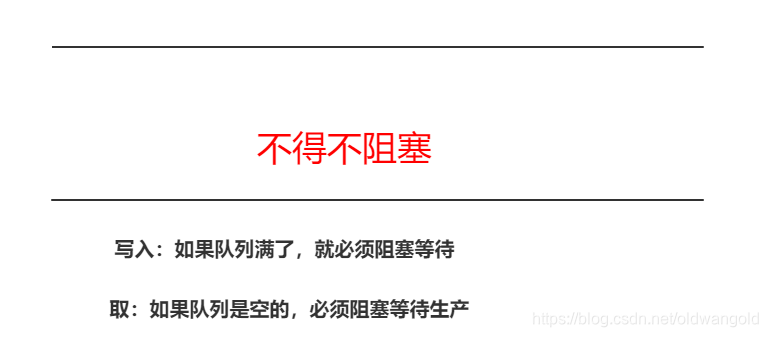
阻塞队列:
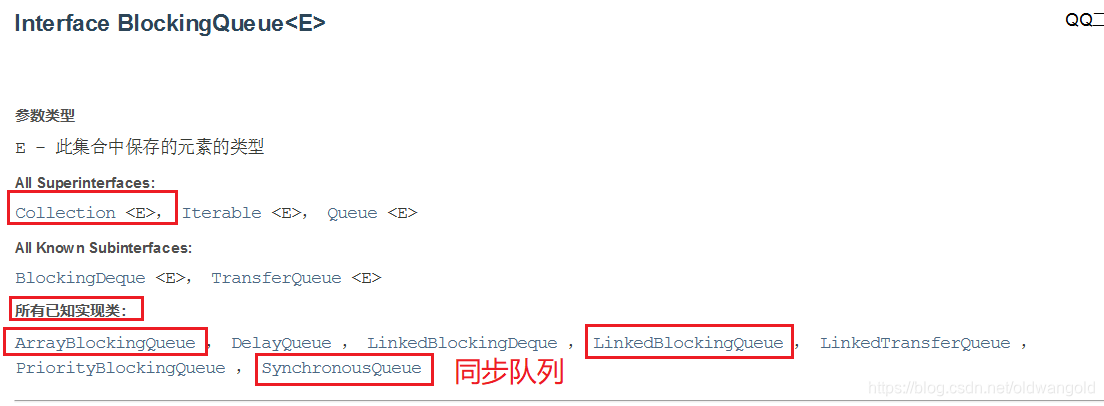
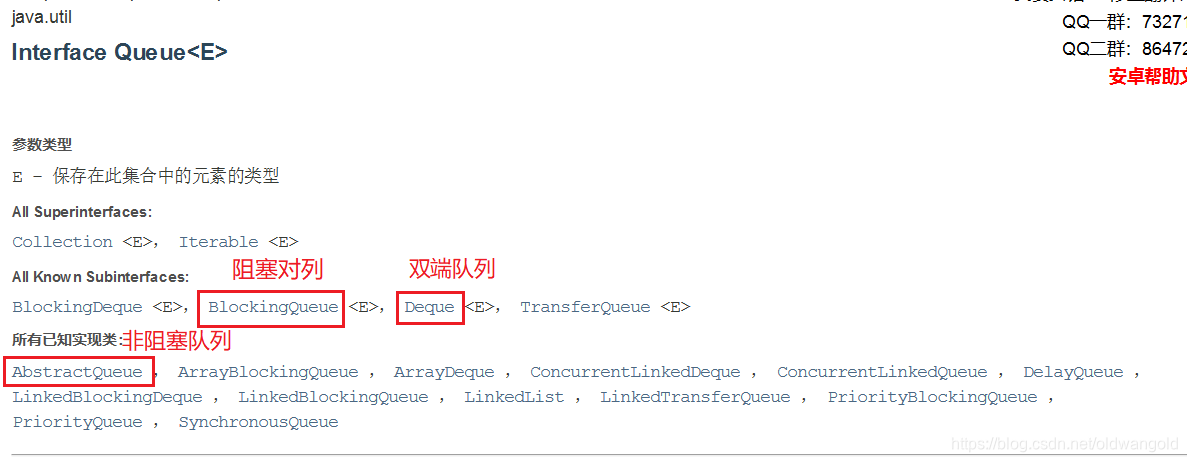
BlockingQueue BlockingQueue不是新的东西
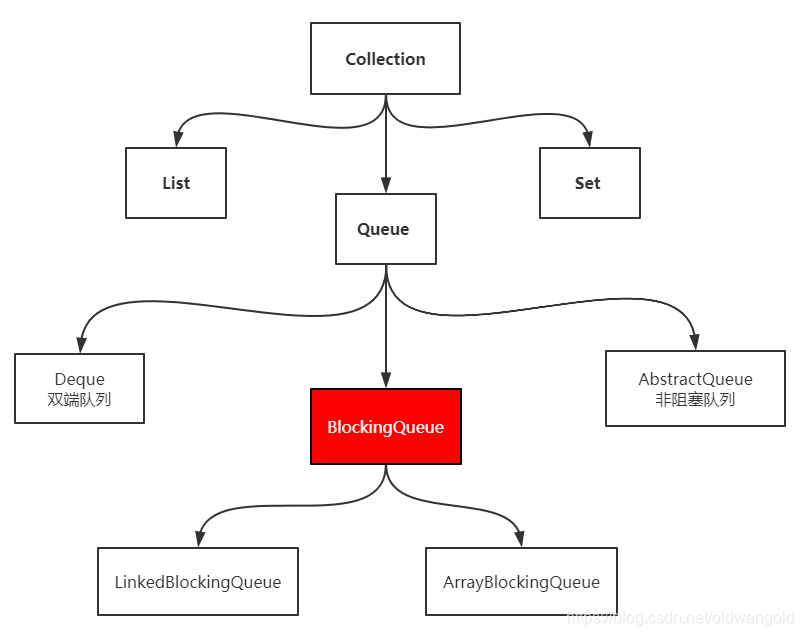
什么情况下使用阻塞对列:多线程并发处理,线程池!
学会使用队列
添加、移除
四组API
| 方式 | 抛出异常 | 有返回值,不抛出异常 | 阻塞等待 | 超时等待 |
|---|---|---|---|---|
| 添加 | add() | offer() | put() | offer(e, timeout, TimeUnit) |
| 移除 | remove() | poll() | take() | poll(timeout, TimeUnit) |
| 检测队首元素 | element() | peek() | - | - |
/**
* 抛出异常
*/
public static void test1() {
// 队列的大小
ArrayBlockingQueue blockingQueue = new ArrayBlockingQueue<>(3);
System.out.println(blockingQueue.add("a"));
System.out.println(blockingQueue.add("b"));
System.out.println(blockingQueue.add("c"));
// java.lang.IllegalStateException: Queue full 抛出异常
//System.out.println(blockingQueue.add("d"));
System.out.println(blockingQueue.element()); // 查看队首元素是谁
System.out.println("============================");
System.out.println(blockingQueue.remove());
System.out.println(blockingQueue.remove());
System.out.println(blockingQueue.remove());
// java.util.NoSuchElementException
//System.out.println(blockingQueue.remove());
}
/**
* 有返回值,没有异常
*/
public static void test2() {
// 队列的大小
ArrayBlockingQueue blockingQueue = new ArrayBlockingQueue<>(3);
System.out.println(blockingQueue.offer("a"));
System.out.println(blockingQueue.offer("b"));
System.out.println(blockingQueue.offer("c"));
System.out.println(blockingQueue.peek());
//System.out.println(blockingQueue.offer("d")); // 返回false,不抛出异常!
System.out.println("=============================");
System.out.println(blockingQueue.poll());
System.out.println(blockingQueue.poll());
System.out.println(blockingQueue.poll());
System.out.println(blockingQueue.poll()); // 返回null,不抛出异常!
}
/**
* 等待,阻塞(一直阻塞)
*/
public static void test3() throws InterruptedException {
// 队列的大小
ArrayBlockingQueue blockingQueue = new ArrayBlockingQueue<>(3);
// 一直阻塞
blockingQueue.put("a");
blockingQueue.put("b");
blockingQueue.put("c");
//blockingQueue.put("d"); // 队列没有位置,一直阻塞
System.out.println(blockingQueue.take());
System.out.println(blockingQueue.take());
System.out.println(blockingQueue.take());
System.out.println(blockingQueue.take()); // 没有这个元素,一直阻塞
}
/**
* 等待,阻塞(等待超时)
*/
public static void test4() throws InterruptedException {
// 队列的大小
ArrayBlockingQueue blockingQueue = new ArrayBlockingQueue<>(3);
System.out.println(blockingQueue.offer("a"));
System.out.println(blockingQueue.offer("b"));
System.out.println(blockingQueue.offer("c"));
//System.out.println(blockingQueue.offer("d",2,TimeUnit.SECONDS)); // 等待超过2秒就退出
System.out.println("====================");
System.out.println(blockingQueue.poll());
System.out.println(blockingQueue.poll());
System.out.println(blockingQueue.poll(2,TimeUnit.SECONDS)); // 等待超过2秒就退出
}
SynchronousQueue 同步队列
没有容量,进去一个元素,必须等待取出来之后,才能再往里面放一个元素!
put、take
package com.won.bq;
import java.util.concurrent.BlockingQueue;
import java.util.concurrent.SynchronousQueue;
import java.util.concurrent.TimeUnit;
/**
* 同步队列
* 和其他的 BlockingQueue 不一样,SynchronousQueue 不存储元素
* put 了一个元素,必须从里面先 take 取出来,否则不能再 put 进去值
*/
public class SynchronousQueueDemo {
public static void main(String[] args) {
// 同步队列
BlockingQueue<String> blockingQueue = new SynchronousQueue<>();
new Thread(()->{
try {
System.out.println(Thread.currentThread().getName()+" put 1");
blockingQueue.put("1");
System.out.println(Thread.currentThread().getName()+" put 2");
blockingQueue.put("2");
System.out.println(Thread.currentThread().getName()+" put 3");
blockingQueue.put("3");
} catch (InterruptedException e) {
e.printStackTrace();
}
},"T1").start();
new Thread(()->{
try {
TimeUnit.SECONDS.sleep(3);
System.out.println(Thread.currentThread().getName()+ " take " + blockingQueue.take());
TimeUnit.SECONDS.sleep(3);
System.out.println(Thread.currentThread().getName()+ " take " + blockingQueue.take());
TimeUnit.SECONDS.sleep(3);
System.out.println(Thread.currentThread().getName()+ " take " + blockingQueue.take());
} catch (InterruptedException e) {
e.printStackTrace();
}
},"T2").start();
}
}
11、线程池(重点)
线程池:三大方法、7大参数、4种拒绝策略
池化技术
程序的运行,本质:占用系统的资源!优化资源的使用 => 池化技术
线程池、连接池、内存池、对象池……创建和销毁,十分浪费资源
池化技术:事先准备好一些资源,有人要用,就来这里拿,用完之后再还!
线程池的好处:
- 降低资源的消耗
- 提高响应速度
- 方便管理
线程复用、可以控制最大并发数、管理线程
线程池:三大方法
package com.won.pool;
import java.util.concurrent.ExecutorService;
import java.util.concurrent.Executors;
// Executors 工具类、3大方法
public class Demo01 {
public static void main(String[] args) {
//ExecutorService threadPool = Executors.newSingleThreadExecutor();// 单个线程
//ExecutorService threadPool = Executors.newFixedThreadPool(5); // 创建一个固定的线程池的大小
ExecutorService threadPool = Executors.newCachedThreadPool(); // 可伸缩的,遇强则强,遇弱则弱
try {
for (int i = 0; i < 10; i++) {
// 使用了线程池之后,使用线程池来创建线程
threadPool.execute(()->{
System.out.println(Thread.currentThread().getName() + " ok");
});
}
} catch (Exception e) {
e.printStackTrace();
} finally {
// 线程池用完,程序结束,关闭线程池
threadPool.shutdown();
}
}
}
7大参数
public static ExecutorService newSingleThreadExecutor() {
return new FinalizableDelegatedExecutorService
(new ThreadPoolExecutor(1, 1,
0L, TimeUnit.MILLISECONDS,
new LinkedBlockingQueue<Runnable>()));
}
public static ExecutorService newFixedThreadPool(int nThreads) {
return new ThreadPoolExecutor(nThreads, nThreads,
0L, TimeUnit.MILLISECONDS,
new LinkedBlockingQueue<Runnable>());
}
public static ExecutorService newCachedThreadPool() {
return new ThreadPoolExecutor(0, Integer.MAX_VALUE,
60L, TimeUnit.SECONDS,
new SynchronousQueue<Runnable>());
}
本质:ThreadPoolExecutor
public ThreadPoolExecutor(
// 核心线程池大小
int corePoolSize,
// 最大核心线程池大小
int maximumPoolSize,
// 超时了没有人调用就会释放
long keepAliveTime,
// 超时单位
TimeUnit unit,
// 阻塞队列
BlockingQueue<Runnable> workDeque,
// 线程工厂:创建线程的,一般不用动
ThreadFactory threadFactory,
// 拒绝策略
RejectedExecutionHandler handler) {
if (corePoolSize < 0 ||
maximumPoolSize <= 0 ||
maximumPoolSize < corePoolSize ||
keepAliveTime < 0)
throw new IllegalArgumentException();
if (workQueue == null || threadFactory == null || handler == null)
throw new NullPointerException();
this.acc = System.getSecurityManager() == null ?
null :
AccessController.getContext();
this.corePoolSize = corePoolSize;
this.maximumPoolSize = maximumPoolSize;
this.workQueue = workQueue;
this.keepAliveTime = unit.toNanos(keepAliveTime);
this.threadFactory = threadFactory;
this.handler = handler;
}

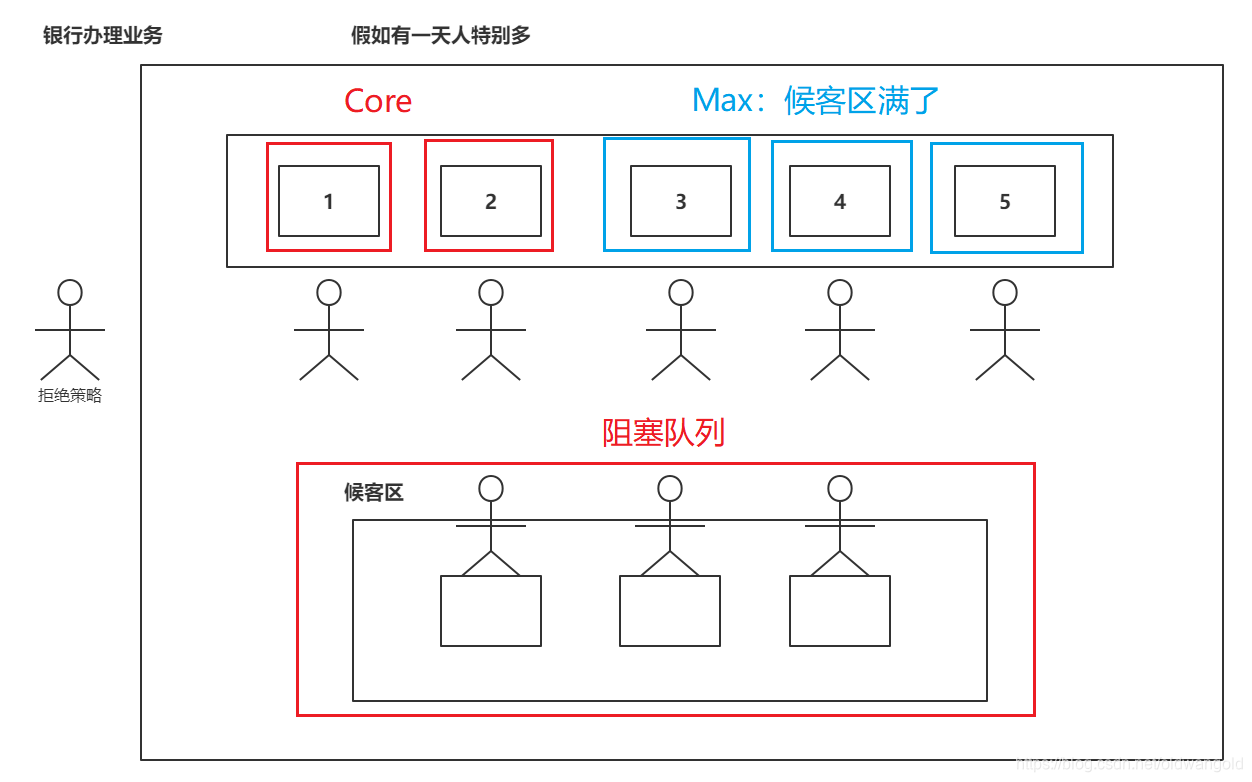
手动创建线程池
package com.won.pool;
import java.util.concurrent.*;
// Executors 工具类、3大方法
/**
* new ThreadPoolExecutor.AbortPolicy() // 银行满了,还有人进来,不处理这个人,抛出异常
* new ThreadPoolExecutor.CallerRunsPolicy() // 哪来的去哪里!
* new ThreadPoolExecutor.DiscardPolicy() // 队列满了,丢掉任务,不抛出异常!
* new ThreadPoolExecutor.DiscardOldestPolicy() // 队列满了,尝试去和最早的竞争,也不抛出异常!
*/
public class Demo01 {
public static void main(String[] args) {
// 自定义线程池!工作中只会手动创建 ThreadPoolExecutor
ThreadPoolExecutor threadPool = new ThreadPoolExecutor(
2,
5,
3,
TimeUnit.SECONDS,
new LinkedBlockingDeque<>(3),
Executors.defaultThreadFactory(),
new ThreadPoolExecutor.DiscardOldestPolicy()); // 队列满了,尝试去和最早的竞争,也不抛出异常!
try {
// 最大承载:Deque + max
// 超过:RejectedExecutionException
for (int i = 1; i <= 9; i++) {
// 使用了线程池之后,使用线程池来创建线程
threadPool.execute(()->{
System.out.println(Thread.currentThread().getName() + " ok");
});
}
} catch (Exception e) {
e.printStackTrace();
} finally {
// 线程池用完,程序结束,关闭线程池
threadPool.shutdown();
}
}
}
四种拒绝策略

/**
* new ThreadPoolExecutor.AbortPolicy() // 银行满了,还有人进来,不处理这个人,抛出异常
* new ThreadPoolExecutor.CallerRunsPolicy() // 哪来的去哪里!
* new ThreadPoolExecutor.DiscardPolicy() // 队列满了,丢掉任务,不抛出异常!
* new ThreadPoolExecutor.DiscardOldestPolicy() // 队列满了,尝试去和最早的竞争,也不抛出异常!
*/
小结 和 拓展
池的最大的大小如何去设置!
了解:IO密集型,CPU密集型:(调优)
package com.won.pool;
import java.util.concurrent.*;
public class Demo01 {
public static void main(String[] args) {
// 自定义线程池!工作中只会手动创建 ThreadPoolExecutor
// 最大线程的到底如何定义
// 1、CPU 密集型,几核,就是几,可以保持CPU效率最高!
// 2、IO 密集型 > 判断你程序中十分耗IO的线程(一般为2倍)
// 程序 15个大型任务 IO十分占用资源!
// 获取CPU的核数
System.out.println(Runtime.getRuntime().availableProcessors());
ThreadPoolExecutor threadPool = new ThreadPoolExecutor(
2,
Runtime.getRuntime().availableProcessors(),
3,
TimeUnit.SECONDS,
new LinkedBlockingDeque<>(3),
Executors.defaultThreadFactory(),
new ThreadPoolExecutor.DiscardOldestPolicy()); // 队列满了,尝试去和最早的竞争,也不抛出异常!
try {
// 最大承载:Deque + max
// 超过:RejectedExecutionException
for (int i = 1; i <= 9; i++) {
// 使用了线程池之后,使用线程池来创建线程
threadPool.execute(()->{
System.out.println(Thread.currentThread().getName() + " ok");
});
}
} catch (Exception e) {
e.printStackTrace();
} finally {
// 线程池用完,程序结束,关闭线程池
threadPool.shutdown();
}
}
}
12、四大函数式接口(必须掌握)
新时代的程序员:lambda表达式、链式编程、函数式接口、Stream流式计算
函数式接口:只有一个方法的接口
@FunctionalInterface
public interface Runnable {
public abstract void run();
}
// 泛型、枚举、反射
// lambda表达式、链式编程、函数式接口、Stream流式计算
// 超级多 FunctionalInterface
// 简化编程模型,在新版本的框架底层大量使用
// foreach(消费者类型的函数式接口)
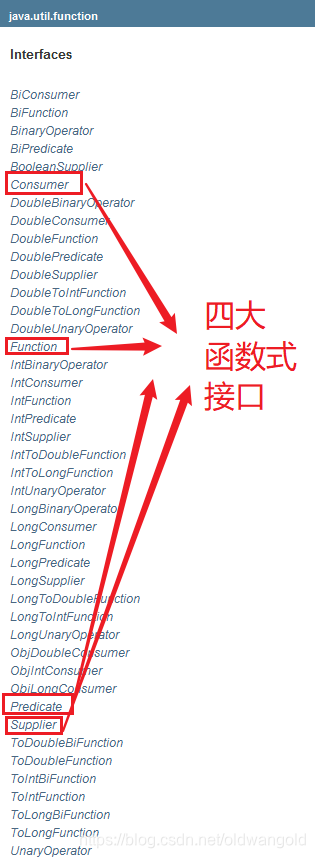
代码测试:
Function 函数型接口
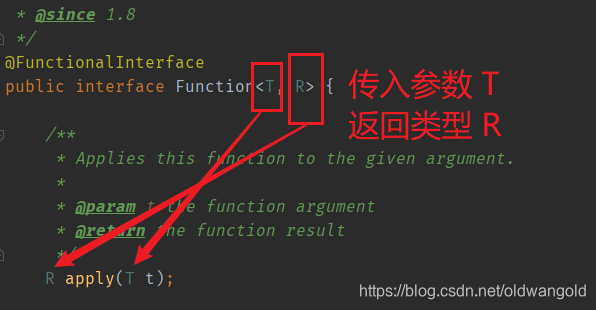
package com.won.function;
import java.util.function.Function;
/**
* Function 函数式接口,有一个输入参数,有一个输出
* 只要是函数式接口,可以用lambda表达式简化
*/
public class Demo01 {
public static void main(String[] args) {
// 工具类:输出输入的值
//Function function = new Function<String,String>() {
// @Override
// public String apply(String str) {
// return str;
// }
//};
Function<String,String> function = (str)->{return str;};
System.out.println(function.apply("ads"));
}
}
Predicate 断定型接口:有一个输入参数,返回值只能是 布尔值
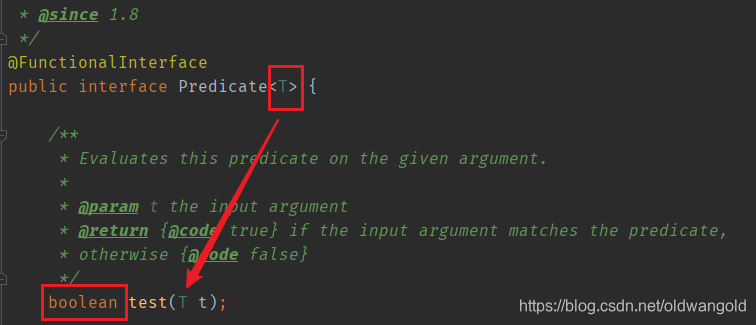
package com.won.function;
import java.util.function.Predicate;
/**
* 断定型接口:有一个输入参数,返回值只能是 布尔值
*/
public class Demo02 {
public static void main(String[] args) {
// 判断字符串是否为空
//Predicate<String> predicate = new Predicate<String>() {
// @Override
// public boolean test(String str) {
// return str.isEmpty();
// }
//};
Predicate<String> predicate = (str)->{return str.isEmpty();};
System.out.println(predicate.test(""));
}
}
Consumer 消费型接口
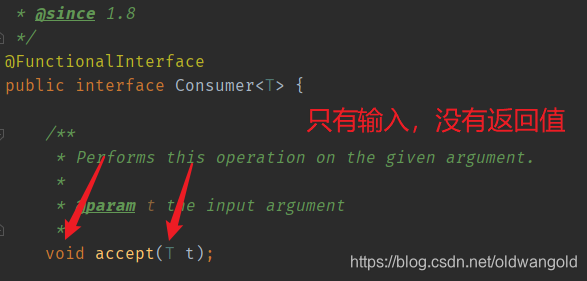
package com.won.function;
import java.util.function.Consumer;
/**
* Consumer 消费型接口:只有输入,没有返回值
*/
public class Demo03 {
public static void main(String[] args) {
//Consumer<String> consumer = new Consumer<String>() {
// @Override
// public void accept(String str) {
// System.out.println(str);
// }
//};
Consumer<String> consumer = (str)->{System.out.println(str);};
consumer.accept("ads");
}
}
Supplier 供给型接口
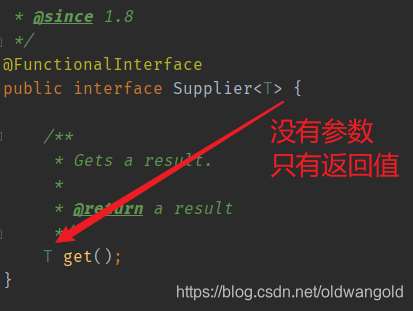
package com.won.function;
import java.util.function.Supplier;
/**
* Supplier 供给型接口 没有参数,只有返回值
*/
public class Demo04 {
public static void main(String[] args) {
//Supplier<Integer> supplier = new Supplier<Integer>() {
// @Override
// public Integer get() {
// System.out.println("get() ");
// return 1024;
// }
//};
Supplier<Integer> supplier = ()->{
System.out.println("get() ");
return 1024;
};
System.out.println(supplier.get());
}
}
13、Stream流计算
什么是Stream流计算
大数据:存储+计算
集合、MySQL 本质就是存储东西的;
计算都应该交给流来操作!
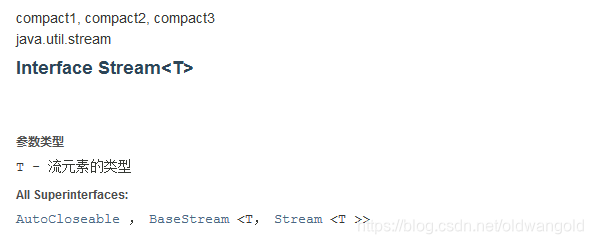
package com.won.stream;
import lombok.AllArgsConstructor;
import lombok.Data;
import lombok.NoArgsConstructor;
@Data
@AllArgsConstructor
@NoArgsConstructor
public class User {
private int id;
private String name;
private int age;
}
package com.won.stream;
import java.util.Arrays;
import java.util.List;
/**
* 题目要求:一分钟内完成此题,只能用一行代码实现!
* 现在有5个用户!筛选:
* 1、ID必须是偶数
* 2、年龄必须大于23岁
* 3、用户名转为大写字母
* 4、用户名字母倒着排序
* 5、只输出一个用户!
*/
public class Test {
public static void main(String[] args) {
User u1 = new User(1, "a", 21);
User u2 = new User(2, "b", 22);
User u3 = new User(3, "c", 23);
User u4 = new User(4, "d", 24);
User u5 = new User(6, "e", 25);
// 集合就是存储
List<User> list = Arrays.asList(u1, u2, u3, u4, u5);
// 计算交给Stream流
// lambda表达式、链式编程、函数式接口、Stream流式计算
list.stream()
.filter(u -> {return u.getId()%2==0;})
.filter(u->{return u.getAge() > 23;})
.map(u->{return u.getName().toUpperCase();})
.sorted((uu1,uu2)->{return uu2.compareTo(uu1);})
.limit(1)
.forEach(System.out::println);
}
}
14、ForkJoin
什么是ForkJoin
ForkJoin 在 JDK1.7 之后出来的,并行执行任务!提高效率,大数据量!
大数据:Map Reduce(把大任务拆分为小任务)
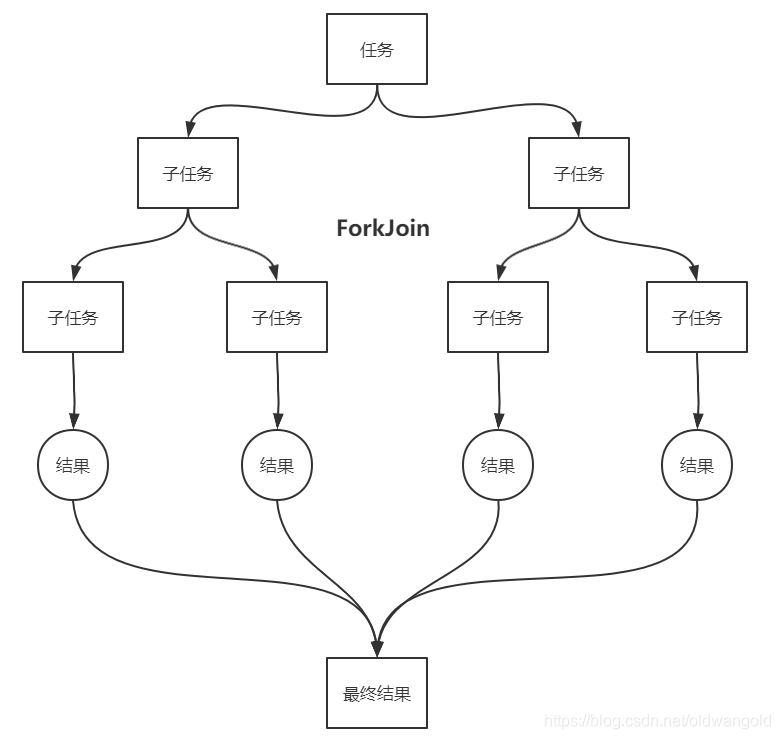
ForkJoin特点:工作窃取
这个里面维护的都是双端队列。
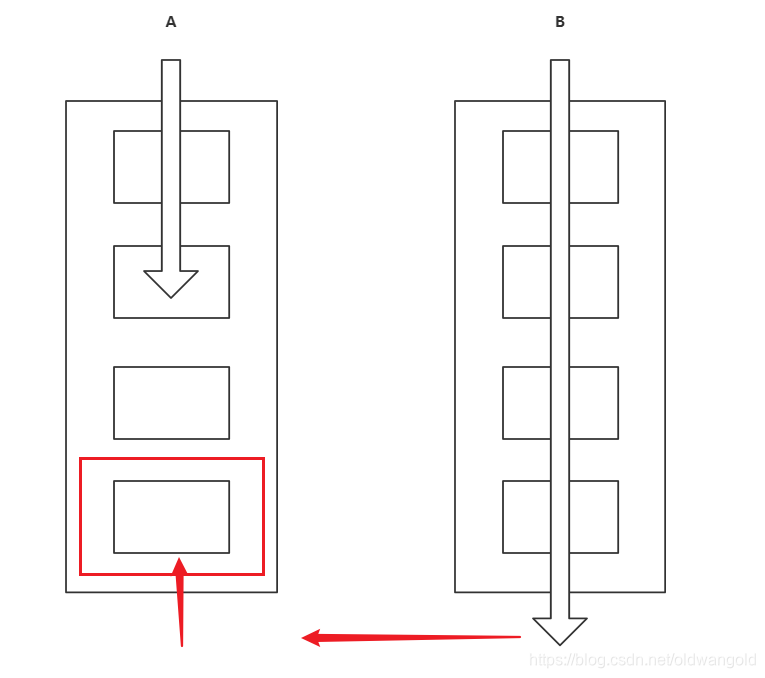
ForkJoin的操作

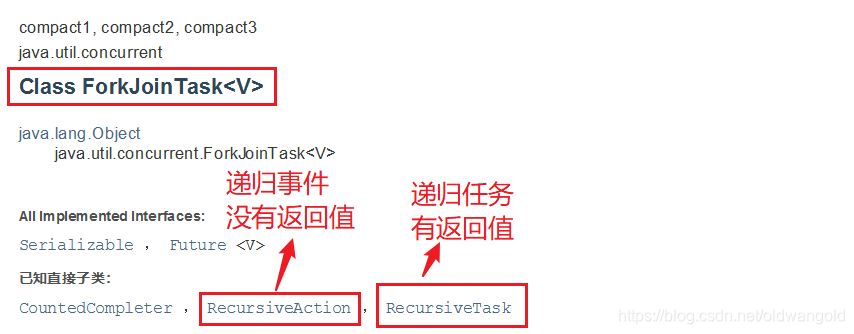
package com.won.forkjoin;
import java.util.concurrent.RecursiveTask;
/**
* 求和计算的任务
* 3000 6000(ForkJoin) 9000(Stream并行流)
* // 如何使用ForkJoin
* // 1、ForkJoinPool 通过它来是执行
* // 2、计算任务 ForkJoinPool.execute(ForkJoinTask<?> task)
* // 3、计算类要继承 ForkJoinTask
*/
public class ForkJoinDemo extends RecursiveTask<Long> {
private long start;
private long end;
// 临界值
private long temp = 10000L;
public ForkJoinDemo(long start, long end) {
this.start = start;
this.end = end;
}
// 计算方法
@Override
protected Long compute() {
if ((end-start)<temp) {
long sum = 0L;
for (long i = start; i < end; i++) {
sum += i;
}
return sum;
} else { // ForkJoin 递归
// 分支合并运算
// 中间值
long middle = (start + end) / 2;
ForkJoinDemo task1 = new ForkJoinDemo(start, middle);
task1.fork(); // 拆分任务,把任务压入线程队列
ForkJoinDemo task2 = new ForkJoinDemo(middle+1, end);
task2.fork(); // 拆分任务,把任务压入线程队列
return task1.join()+task2.join();
}
}
}
package com.won.forkjoin;
import java.util.concurrent.ExecutionException;
import java.util.concurrent.ForkJoinPool;
import java.util.concurrent.ForkJoinTask;
import java.util.stream.LongStream;
public class Test {
public static void main(String[] args) throws ExecutionException, InterruptedException {
test1(); // 260
test2(); // 136
test3(); // 149
}
// 普通程序员
public static void test1() {
long sum = 0L;
long start = System.currentTimeMillis();
for (long i = 1L; i < 10_0000_0000; i++) {
sum += i;
}
long end = System.currentTimeMillis();
System.out.println("sum=" + sum + " 时间:"+(end-start));
}
// 会使用ForkJoin
public static void test2() throws ExecutionException, InterruptedException {
long start = System.currentTimeMillis();
ForkJoinPool forkJoinPool = new ForkJoinPool();
ForkJoinTask<Long> task = new ForkJoinDemo(0L, 10_0000_0000L);
ForkJoinTask<Long> submit = forkJoinPool.submit(task); // 提交任务
Long sum = submit.get();
long end = System.currentTimeMillis();
System.out.println("sum=" + sum + " 时间:"+(end-start));
}
public static void test3() {
long start = System.currentTimeMillis();
// Stream并行流
long sum = LongStream.rangeClosed(0L, 10_0000_0000L).parallel().reduce(0, Long::sum);
long end = System.currentTimeMillis();
System.out.println("sum=" + sum + "时间:"+(end-start));
}
}
15、异步回调
Future 设计的初衷:对将来的某个事件的结果进行建模
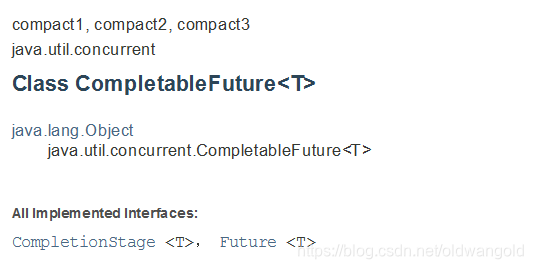
package com.won.future;
import java.util.concurrent.CompletableFuture;
import java.util.concurrent.ExecutionException;
import java.util.concurrent.TimeUnit;
/**
* 异步调用:Ajax
* // 异步执行
* // 成功回调
* // 失败回调
*/
public class Demo01 {
public static void main(String[] args) throws ExecutionException, InterruptedException {
// 没有返回值的runAsync 异步回调
//CompletableFuture<Void> completableFuture = CompletableFuture.runAsync(()->{
// try {
// TimeUnit.SECONDS.sleep(2);
// } catch (InterruptedException e) {
// e.printStackTrace();
// }
// System.out.println(Thread.currentThread().getName()+" runAsync=>Void");
//});
//System.out.println("111111");
//completableFuture.get(); // 获取阻塞执行结果
// 有返回值的supplyAsync 异步回调
CompletableFuture<Integer> completableFuture = CompletableFuture.supplyAsync(()->{
System.out.println(Thread.currentThread().getName() + " supplyAsync=>Integer");
int i = 10/0;
return 1024;
});
System.out.println(completableFuture.whenComplete((t, u) -> {
System.out.println("t=>" + t); // 正常的返回结果
System.out.println("u=>" + u); // 错误信息:java.util.concurrent.CompletionException: java.lang.ArithmeticException: / by zero
}).exceptionally((e) -> {
System.out.println(e.getMessage());
return 233; // 可以获取到错误的返回结果
}).get());
}
}





















 3264
3264

 被折叠的 条评论
为什么被折叠?
被折叠的 条评论
为什么被折叠?








